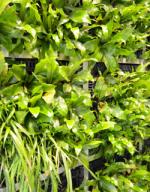Concrete is the world’s most widely used construction material, but it’s highly carbon intensive. In Australia, the concrete sector is the second highest greenhouse gas emitter of all industries nationally, releasing five megatons of emissions into the atmosphere every year.
Developing sustainable alternatives is key to reducing the environmental impact of the built environment – and a new UTS-led ARC Linkage project is seeking to do just that.
Led by Professor Arnaud Castel from the UTS Faculty of Engineering and IT, a multi-disciplinary team of researchers will carry out ground-breaking research on two established products. Hempcrete is a bio-based material made from hemp, a fast-growing renewable plant source. Green walls are the increasingly popular ‘urban jungles’ grown on building exteriors to provide insulation, reduce noise and improve air quality.
The research team has two objectives: to develop a novel low-carbon binder (the material that binds hempcrete together), and to create an integrated, prefabricated panel that uses both hempcrete and green wall technologies.
“The first step is to improve the hempcrete itself by further reducing the embodied carbon, which is already very low compared to traditional concrete, and then to combine the two technologies,” says Professor Castel.
Greater than the sum of its parts
Hempcrete offers significant potential to reduce the carbon impact of the built environment. Hemp-embedded building products are less carbon and energy intensive to produce than traditional alternatives, can capture and store carbon, and are highly resistant to biodegradation over time.
Previous research also suggests that hempcrete has excellent thermal insulation properties and enables greater control of interior environmental quality.
However, hempcrete binders have traditionally been made of hydraulic or hydrated lime, both carbon intensive materials. Replacing this binder with a sustainable alternative will significantly increase hempcrete’s environmental credentials.
Potentially, we can develop a carbon-positive material, so the more of it that can be embedded in the building, the less carbon there is in the atmosphere
Professor Arnaud Castel
Similarly, green walls offer a wealth of sustainability benefits: they can decrease outdoor surface temperatures; in turn, this can improve indoor temperatures and increase overall thermal performance, reducing reliance on artificial cooling systems and the energy required to power them.
Further, as living ecosystems, green walls can remove pollutants from the air, and they can also slow stormwater runoff, thereby reducing the severity of potential floods. Green walls provide a habitat for biodiversity and contribute to the biophilia effect, which is the sense of wellbeing and calm humans experience when exposed to nature.
By combining hempcrete and green walls to create prefabricated panels, the research team is hoping to leverage the inherent value of both products to create a solution that’s greater than the sum of its parts. And it comes at a critical time in Australia’s environmental history: as climate instability becomes more commonplace, decarbonising our urban environments will be a crucial component of protecting the future of our planet.
“When we’re looking at cities and trying to reach net zero, the only way that we can achieve this is by looking at all different aspects of buildings in a city and thinking about how we can implement all these sustainable technologies at once,” says UTS DECRA Fellow and project team member Dr Peter Irga.
Creating healthier environments for life and work
The research is funded by $240,000 from the ARC Linkage scheme and pairs the UTS researchers with collaborators from the UNSW Sydney, the University of Sydney, and industry partner the Australian Hemp Masonry Company.
From an industry standpoint, the project could open the door to significant growth in hemp-based building products, which are yet to take off in a big way in Australia.
“We need to bring more hemp building products to the market, because the building industry needs to reduce its footprint and because people need heathier environments to live and work in,” says Klara Marosszeky, Managing Director of the Australian Hemp Masonry Company.
“There's a great need to educate the broader community and educating building professionals is a big part of that. We feel that these broader objectives could be achieved through the UTS team we're working with, because they're as passionate about the project as we are.”
The project launched in December 2021, with preliminary results expected in 2023.
Research team
-
UTS Faculty of Engineering and IT
-
UTS Faculty of Design, Architecture and Building
-
UTS Faculty of Engineering and IT
-
Faculty of Engineering and IT
-
Faculty of Engineering and IT
-
Faculty of Engineering and IT
-
UNSW Sydney
-
University of Sydney
-
UNSW Sydney
-
UNSW Sydney
-
Klara MarosszekyAustralian Hemp Masonry
-
University of Colorado Boulder









